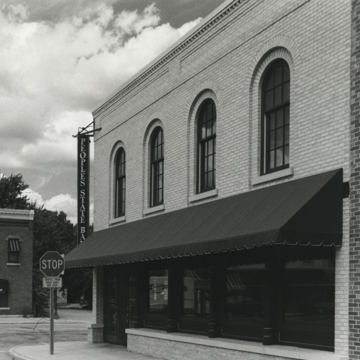Downtown Mazomanie exemplifies the small railroad towns that once grew along the rail lines across Wisconsin. The Milwaukee and Mississippi Railroad Company, the first in the state, platted Mazomanie in 1855 at the spot where the rail line was to intersect with several trunk roads and with Black Earth Creek, a prospective mill power source. The railroad launched Mazomanie on a thirty-year boom. That period of prosperity is today represented in the downtown, where late-nineteenth-century buildings still form a visually cohesive collection of commercial architecture. More than one-fourth of the thirty buildings here were constructed before 1870, and most were constructed by 1900.
The Mazomanie Railroad Depot (1857; 102 Brodhead Street), now the library, is one of Wisconsin’s oldest remaining railroad depots. Built after fire destroyed the original station, it is a two-story building with clapboard walls and a front-gabled roof. The original freight room and the sheltered platforms have been removed. Also among the oldest buildings in the district are the Charles Butz Store Building (8–10 Brodhead), which housed a general store, and the Frank Dietz Store Building (6 Brodhead). Both were constructed c. 1863 and retain their original storefronts, with recessed entrances and cast-iron columns. The Dietz Building’s pediment, flat lintels, and decorative corbeled-brick cornice, embellished by a zigzag dogtooth course, reflect Greek Revival influences.
The Masonic Lodge (1888; 2 Brodhead), one of the district’s most impressive commercial buildings, was erected by contractor James Owens. The cast-iron storefront features columns embellished by a garland. The tall second story once housed the Masonic Lodge hall, and the pediments above the second-story windows still display Masonic emblems incised in the keystones. Contractor Stillman Moulton built the elegant Italianate J. A. Schmitz Block (1879; 18 Brodhead), giving it a bracketed cornice, a brick dentil course, and pedimented stone window surrounds. The second story originally housed Schmitz Hall, which hosted one of the first performances by the Ringling Brothers Classic and Comic Concert Company, predecessor to the famous circus company.
Among the several utilitarian buildings in the district is the Phillip Hamm Livery Barn (1908; 46 E. Hudson Street), one of the few remaining livery stables in the state. The Lynch and Walker Flouring Mill along the railroad tracks at 113 Cramer Street, now the Old Feed Mill restaurant, grew in several stages between 1857 and 1896. Much of this rough-cut stone building had to be rebuilt after a fire in 1900, but it still looks much as it did in the mid-nineteenth century.















